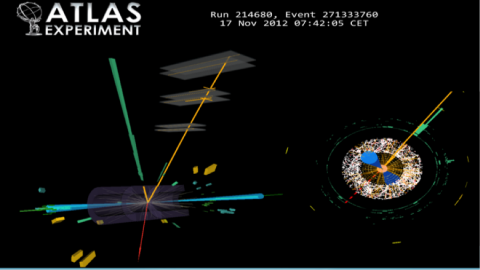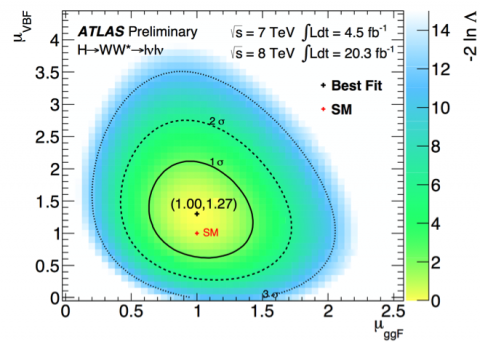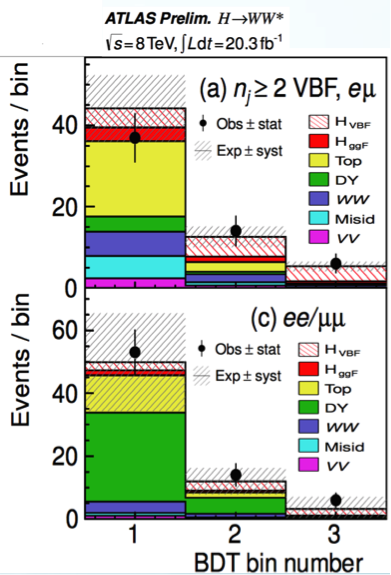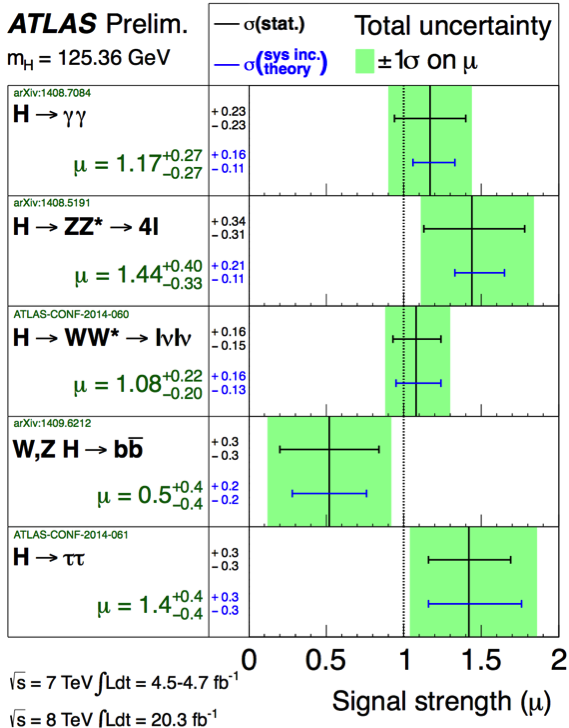

New ATLAS Measurement of the Higgs Boson
Observation of WW Decay, Evidence for VBF Production
The discovery of the Higgs boson has been a major breakthrough in 2012 and resulted in the award of the Nobel Prize in Physics to Francois Englert and Peter Higgs in 2013. The ATLAS collaboration has released the final measurement of the Higgs boson coupling to W bosons using data from the first run of the Large Hadron Collider (LHC). The W bosons are force carriers of the weak nuclear force and, with a mass of about 86 times the proton mass, are quite heavy in comparison to, for example, the massless photon that is the force carrier of the electromagnetic force. In fact, this is the very reason why the Higgs mechanism was initially introduced in the late 1960’s.
The newly optimized analysis studies the Higgs boson in two production modes: the production process where two gluons fuse to form a loop of top quarks that produce the Higgs boson (which provided most of the signal for the discovery in 2012), but also another, much rarer process where two W bosons radiate off colliding quarks and fuse together to produce a Higgs boson, called the vector boson fusion production (VBF). The quarks can be detected in the form of hadronic jets in dedicated forward calorimeters called the hadronic endcap–two of which were built at TRIUMF.
A local team of students, postdocs and researchers from TRIUMF (Simon Viel, Doug Schouten and Oliver Stelzer-Chilton) and Simon Fraser University (Koos van Nieuwkoop, Daniel Mori, Heberth Torres and Bernd Stelzer) are part of the ATLAS H->WW effort since the Higgs boson discovery and its characterization in 2013. The team has since led the Higgs boson search in the VBF production mode. The group employed advanced analysis techniques and novel ways to estimate the systematic uncertainties in order to increase the sensitivity of this analysis by more than 50% from previous iterations. In this channel the Higgs boson couples to W bosons in both the production and decay and thus allows for stringent constraints on the fundamental W-Higgs coupling. Furthermore, the signal significance in this process alone has now reached 3.2 standard deviations, qualifying for evidence for this rare production channel for the first time.
The combination of the two production modes yields a total significance above 6.1 standard deviations. The analysis of the Higgs boson decay to two W bosons constitutes now the single most precise Higgs boson rate measurement of the ATLAS experiment. The team is preparing for more detailed studies of the Higgs sector in Run 2 starting in the spring of next year.
–Prepared by the Communications Office
Based on the result summary.
Figure 1: Candidate Event for H->WW->lvlv (VBF) with characteristic hadronic jets in the forward directions.
Figure 2: Likelihood scan as a function of gluon fusion (μggF) and vector boson fusion (μVBF) production.
Figure 3: Final multivariate discriminant separating VBF Higgs events (shaded red) from background.
Figure 4: Updated Higgs boson rate measurements in various Higgs decay channels. The Standard Model predicts a μ value of unity.
 |  | |
